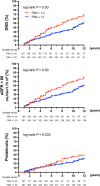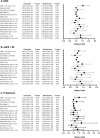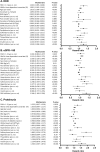High FIB4 index is an independent risk factor of diabetic kidney disease in type 2 diabetes
- PMID: 34083571
- PMCID: PMC8175689
- DOI: 10.1038/s41598-021-88285-6
High FIB4 index is an independent risk factor of diabetic kidney disease in type 2 diabetes
Abstract
Nonalcoholic fatty liver disease (NAFLD) and nonalcoholic steatohepatitis (NASH) may be linked to development of chronic kidney diseases (CKD). The FIB4 index, a noninvasive liver fibrosis score, has been reported to predict CKD in non-diabetic patients, but there are no reports yet in diabetic cases. Therefore, we evaluated the prognostic impact of FIB4 index on the risk of developing diabetic kidney disease (DKD) in Japanese patients with type 2 diabetes in a retrospective cohort study. We assessed patients with type 2 diabetes with an eGFR ≥ 60 mL/min/1.73 m2 and without dipstick positive proteinuria (≥ 1 +) at their first visit to our department. Participants were divided into two groups based on the FIB4 index at their first visit: FIB4 index > 1.3 and FIB4 index ≤ 1.3. The primary endpoint was defined as a decrease in eGFR < 60 mL/min/1.73 m2 or the onset of proteinuria during the course of treatment. The average age of all 584 type 2 diabetic participants (360 [61.6%] men) was 55 ± 11 years. There were 187 patients in the FIB4 index group > 1.3 (32.0%) and the median observation period was 6.0 (3.8-11.0) years. Kaplan-Meier survival analysis indicated that the risks of developing DKD, eGFR < 60 and proteinuria were all higher in FIB4 index > 1.3 patients than in FIB4 ≤ 1.3 patients. In the Cox regression analysis, an FIB4 index > 1.3 was a significant predictor for onset of DKD (HR 1.54, 95% CI 1.15-2.08) and proteinuria (HR 1.55, 95% CI 1.08-2.23), but not for an eGFR < 60 (HR 1.14, 95% CI 0.79-1.99). To the best of our knowledge, this is the first study to demonstrate that an FIB4 index > 1.3 has a prognostic impact on the development of CKD and proteinuria in type 2 diabetic patients. This warrants further investigation of the prognostic impact of the development of DKD or proteinuria.
Conflict of interest statement
The authors declare no competing interests.
Figures





Similar articles
-
Association of Glomerular Complement C4c Deposition With the Progression of Diabetic Kidney Disease in Patients With Type 2 Diabetes.Front Immunol. 2020 Sep 2;11:2073. doi: 10.3389/fimmu.2020.02073. eCollection 2020. Front Immunol. 2020. PMID: 32983156 Free PMC article.
-
Assessment of urinary NGAL for differential diagnosis and progression of diabetic kidney disease.J Diabetes Complications. 2020 Oct;34(10):107665. doi: 10.1016/j.jdiacomp.2020.107665. Epub 2020 Jun 26. J Diabetes Complications. 2020. PMID: 32653382
-
Predictability of noninvasive liver fibrosis score for cardiac events in patients with nonalcoholic fatty liver disease.Nutr Metab Cardiovasc Dis. 2024 Sep;34(9):2115-2123. doi: 10.1016/j.numecd.2024.03.025. Epub 2024 Mar 27. Nutr Metab Cardiovasc Dis. 2024. PMID: 38664121
-
Role of novel biomarker monocyte chemo-attractant protein-1 in early diagnosis & predicting progression of diabetic kidney disease: A comprehensive review.J Natl Med Assoc. 2024 Feb;116(1):33-44. doi: 10.1016/j.jnma.2023.12.001. Epub 2024 Jan 8. J Natl Med Assoc. 2024. PMID: 38195327 Review.
-
Re-understanding and focusing on normoalbuminuric diabetic kidney disease.Front Endocrinol (Lausanne). 2022 Dec 2;13:1077929. doi: 10.3389/fendo.2022.1077929. eCollection 2022. Front Endocrinol (Lausanne). 2022. PMID: 36531487 Free PMC article. Review.
Cited by
-
The impact of non-alcoholic fatty liver disease and liver fibrosis on adverse clinical outcomes and mortality in patients with chronic kidney disease: a prospective cohort study using the UK Biobank.BMC Med. 2023 May 18;21(1):185. doi: 10.1186/s12916-023-02891-x. BMC Med. 2023. PMID: 37198624 Free PMC article.
-
Potential link between high FIB-4 score and chronic kidney disease in metabolically healthy men.Sci Rep. 2022 Oct 5;12(1):16638. doi: 10.1038/s41598-022-21039-0. Sci Rep. 2022. PMID: 36198747 Free PMC article.
-
Factors Associated with Liver Fibrosis in Chinese Patients with Type 2 Diabetes Mellitus and Non-Alcoholic Fatty Liver Disease.Int J Gen Med. 2023 Jan 24;16:293-302. doi: 10.2147/IJGM.S395948. eCollection 2023. Int J Gen Med. 2023. PMID: 36718143 Free PMC article.
-
A High Fibrosis-4 Index is Associated with a Reduction in the Estimated Glomerular Filtration Rate in Non-obese Japanese Patients with Type 2 Diabetes Mellitus.Kobe J Med Sci. 2024 Apr 30;70(1):E39-E45. doi: 10.24546/0100489395. Kobe J Med Sci. 2024. PMID: 38719339 Free PMC article.
-
Healthy lifestyle behaviors, mediating biomarkers, and risk of microvascular complications among individuals with type 2 diabetes: A cohort study.PLoS Med. 2023 Jan 10;20(1):e1004135. doi: 10.1371/journal.pmed.1004135. eCollection 2023 Jan. PLoS Med. 2023. PMID: 36626356 Free PMC article.
References
Publication types
MeSH terms
Substances
LinkOut - more resources
Full Text Sources
Medical
Research Materials
Miscellaneous

